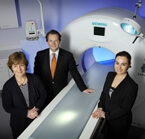
In the new Pediatric Radiology suite, Drs. Melissa Spevak, Thierry Huisman and Aylin Tekes.
It wasn’t too long ago, Division of Pediatric Radiology Director Thierry Huisman notes, that a 4-year-old would find himself in a radiology waiting room sitting next to a 85-year-old man, or a healthy child next to a sick child. That’s because pediatric radiologists shared space with their adult counterparts where they treated both inpatient and outpatients. Also, their offices and the imaging suites they used were dispersed throughout the hospital. In a sense, the division had no home.
No more. Now housed on the fourth floor of the new Charlotte R. Bloomberg Children’s Center, pediatric radiologists—for the first time—have their own dedicated space.
“It’s much more convenient for parents and children to go to one place in a pediatric setting,” says Huisman. “They do not have to walk into a hospital set up for adults.”
Another plus, Huisman notes, is pediatric radiology’s proximity to the pediatric intensive care unit (PICU), pediatric operating rooms, and pre-op and post-op care units, all of which are also on the 4th floor of Bloomberg Children’s Center. That translates into safer transport of pediatric patients and a more rapid response from radiologists. Imaging is safer and more family friendly in the new suite, too, notes Huisman, pointing to separate waiting areas for inpatients and outpatients that reduce their risk of infection. Also, Children’s Center radiologists are using the newest imaging equipment optimized for low-dose radiation, thereby reducing exposure to children.
Family friendly initiatives include glass-enclosed alcoves in the radiology suites to allow young patients to have visual contact with their parents while undergoing imaging. Also, dedicated “quiet rooms,” designed to have a calming, soothing effect on young children awaiting imaging, is helping them avoid general anesthesia. Huisman notes that over a recent two-month period, 13 children scheduled for an imaging study under general anesthesia were able to complete their studies without it thanks to the quiet rooms and the support of the recently recruited fulltime Child Life specialist in Pediatric Radiology.
Having a radiologic reading room in the Pediatric Emergency Department, another first, facilitates greater interaction between pediatric radiologists conducting the studies and ED physicians. “This will greatly improve the quality of interpretation of imaging studies,” says Huisman, “which should make a big difference in service. We’re now a part of the ED team.”
Huisman also notes that thanks to Johns Hopkins leadership’s support, he has been able to grow his division from three pediatric radiologists four years ago to more than six today. That means quicker referrals and more-accurate imaging studies.
“The leaders of Johns Hopkins Medicine made a clear statement that they wanted to offer children the best care possible by building a new high-end hospital and expanding its pediatric radiology expertise,” says Huisman. “The acquisition of new faculty will mean much better end results. And it should be a much more enjoyable experience for patients and their families.”
